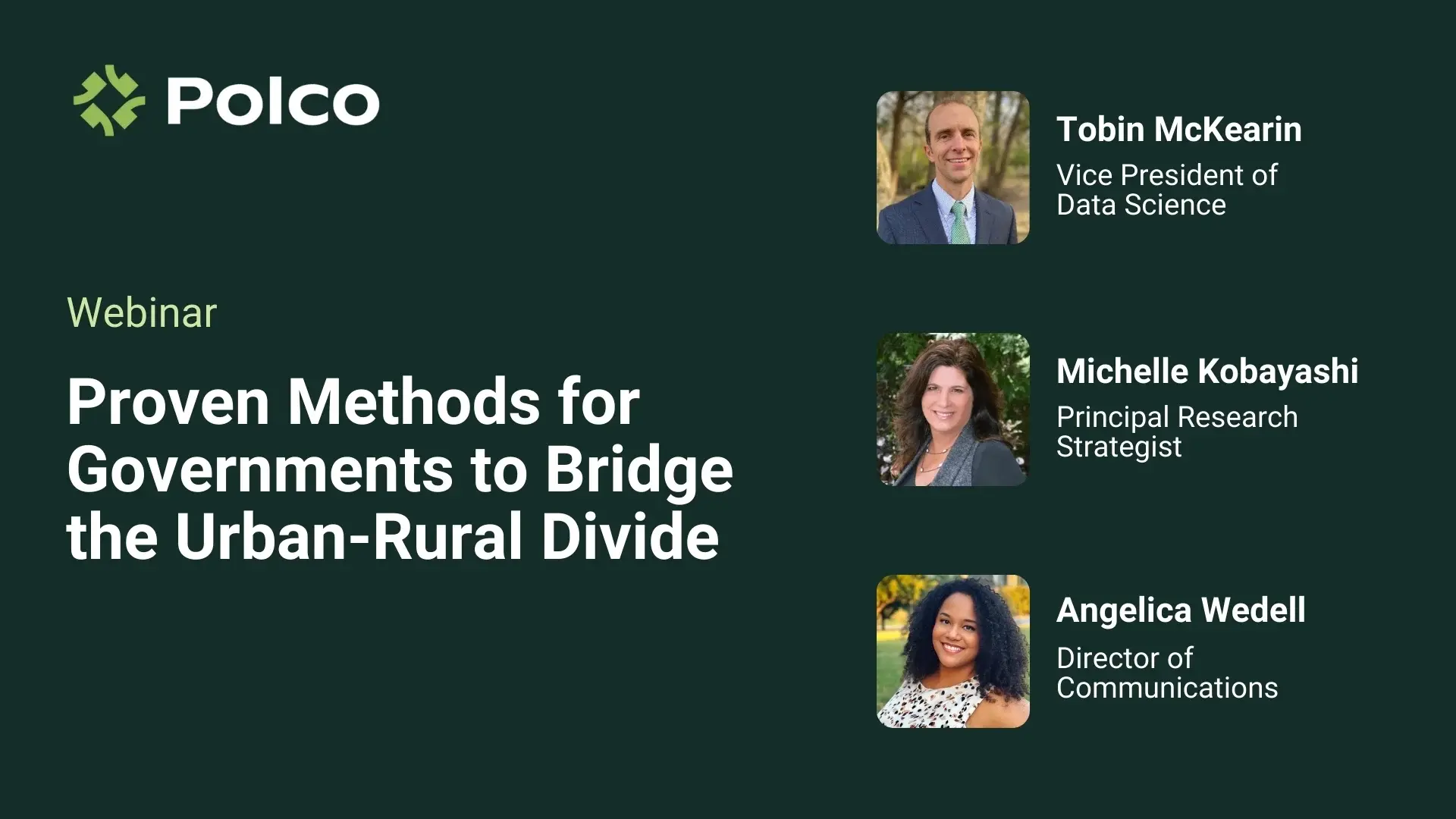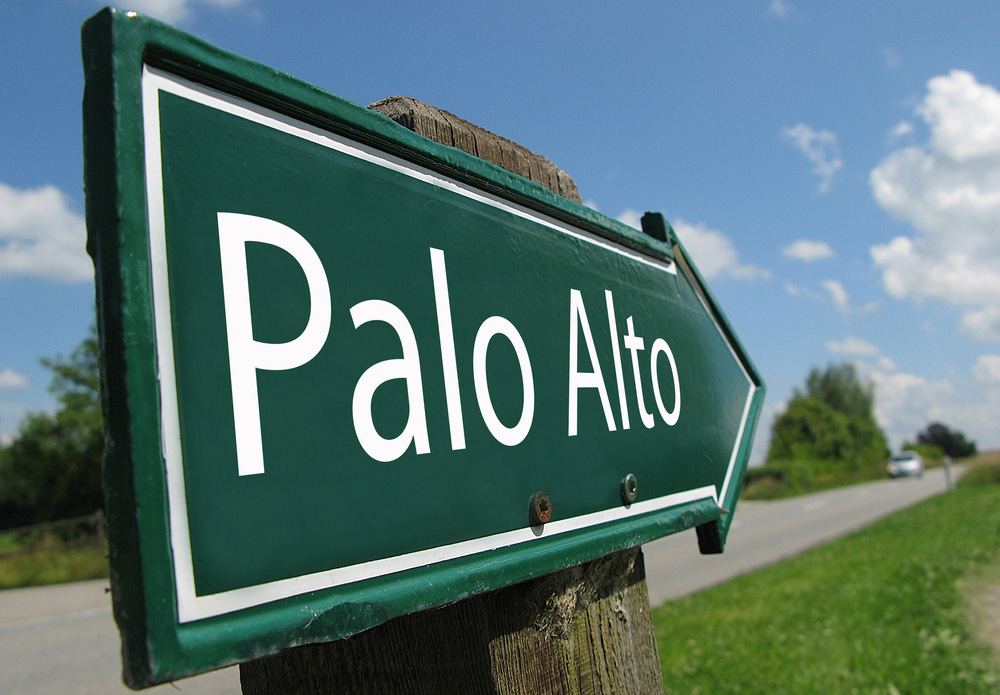Proven Methods for Governments to Bridge the Urban-Rural Divide
By Polco on February 3, 2024

Polco scientists dive into data behind the growing urban-rural divide and discuss proven methods for small, rural towns that can enhance economic prosperity.
There is a growing prosperity and resource divide between urban and rural communities. Both bustling cities and the tranquil countryside have different strengths and weaknesses. But these disparities cause more economic strain for remote, rural jurisdictions.
Luckily, both rural and urban governments can employ data-driven strategies to boost the local economy, improve equity in resource allocation, and level the gaps in their communities.
In this webinar, Polco VP of Data Science Tobin McKearin, and Principal Research Strategist Michelle Kobayashi, present data on the advantages of both big urban cities and small rural towns. Then, Kobayashi presents strategies to help rural governments bridge the gap.

The Strengths and Weaknesses of Urban and Rural Areas
The urban-rural divide is a consequence of economic progress and technological advancements favoring urban centers. Rural areas that once held economic power during industrialization now face challenges due to new industries.
“With progress and advancements in technology and mechanization, we've seen a shift as we've replaced human labor with cognitive thinking and brains replacing brawn,” said Tobin McKearin, Polco’s VP of Data Science.
But even though rural areas face economic challenges, they have many benefits over urban communities.
McKearin and Kobayashi analyzed Polco data to identify the strengths of both places.
The analysis comes from Polco’s Government Performance Action and Learning (GPAL) database. The data come from dozens of public data sources, like the U.S. Census and the Bureau of Labor and Statistics. The data points are hand-picked by scientists, including McKearin, Kobayashi, and others, to more accurately show the quality of life in any community.
Data also come from The National Community Survey (The NCS) by Polco. The NCS is a nationwide assessment that asks residents how they feel about their city and government services.

Polco research found that, in addition to economic opportunities, urban areas excel in health services, infrastructure, and diversity.
In contrast, rural areas outperform their counterparts in safety, affordability, environmental quality, and less congested transportation.
Another huge benefit of rural areas is how residents value community engagement.
 “It is more likely if you're in a rural area, that you are attending these local meetings, that you're volunteering your time, that you have contacted an elected official, and that you also voted in the most recent election,” McKearin says.
“It is more likely if you're in a rural area, that you are attending these local meetings, that you're volunteering your time, that you have contacted an elected official, and that you also voted in the most recent election,” McKearin says.
The good news is that rural areas can leverage their strengths to help close the gaps.

Strategies to Bridge the Urban-Rural Divide
Niche Industries and Micro Businesses
Entrepreneurs in rural areas are using their resources to create specialty products, like honey, oils, soaps, goat cheese, wine, and other artisan goods. The volume is lower, but the prices for these products are higher.
Products such as this serve the growing demand for locally sourced food and products among the foodies, environmentally conscious folks, and champions of local business.
 “About 3000 acres of land are disappearing every day, and farmers who are trying to stay in business are adapting,” Kobayashi says. “They're changing what they sell and what they do. What we're finding is this uprising in niche, specialty, or value-added services.”
“About 3000 acres of land are disappearing every day, and farmers who are trying to stay in business are adapting,” Kobayashi says. “They're changing what they sell and what they do. What we're finding is this uprising in niche, specialty, or value-added services.”
Kobayashi also notes rural cities and counties have the opportunity to pull in new entrepreneurs who cannot afford to pursue their business in urban areas.
Supporting the Maker Economy and Agricultural Workers
The “maker economy” refers to artists who do light manufacturing and sell their products on platforms like Etsy. These people might be looking to take their business further and could benefit from community support. Local governments can do this through zoning laws, like offering up vacant space for pop-ups and promoting businesses.
One success story from a maker-economy comes from Leadville, Colorado, an old mining town at 10,000 feet altitude. A famous local business, Melanzana, known for its outdoor gear, attracts tourists from all over. The desirable clothing is only sold in Leadville—not even online.
Plus, the company hires all of its workers locally. Selling locally-made products in Leadville only drives more tourism to the community and employs more locals.
Kobayashi adds that rural communities can also help their agricultural workers by hosting farmers' markets.
Allowing shared kitchens can also benefit smaller makers who can’t afford to buy their own space but need a larger kitchen to make products.
Agrotourism, Sports Tourism, and Cultural Tourism
“We know a lot of the rural towns have been able to capitalize on tourism, whether you have a ski mountain or you have a fishing lake or things such as that,” Kobayashi said. Oh
People are willing to pay to visit pumpkin patches, wineries, lavender fields, and the like. Kobayashi notes that tourists love educational tours - like wine tours, for instance - where they can see how the products are made and then purchase those products. Oh
Rural communities can also use their history to their advantage.
“Rural America is the storykeeper of a lot of our history, our past, our culture,” Kobayashi says. “A lot of communities still have remnants or information in their communities that they can share and help folks to understand and again and connect to that history that many of us have been disconnected from.” it’s
Kobayashi’s uncle, who was born Amish, built a cultural heritage center in Arthur, Illinois. He saved old Amish barns and transferred them to his land, where people could come view cultural artifacts. Oh
Many communities leverage their beautiful landscapes to host mountain bike races, marathons, and other competitions. Oh
“With all the new trends in ultra athletics, rural communities are geared to accept some of these new kinds of tournaments,” Kobayashi adds.

Festivals and Events
Small towns have always excelled at hosting festivals, which have both economic and community benefits. Kobayashi says The NCS data show this is one aspect of local government that residents like best.
Quartzsite, Arizona, is a small town of 3000 that hosts a popular rock and gem festival, Rockhound. During this time, the town allows RVs to park for free for 14 days out of the year. The idea took off.
“The next thing you know, there are RVs all over America coming to Quartzsite every winter,” Kobayashi says. “There are hundreds and hundreds of people getting together. There are hundreds and hundreds of vendors selling things for RVs, for survivalists, for nomads.”
Working Together: Other Organizations, Economic Clusters, and Institutions
Kobayashi says another way to bridge the divide is by working with other organizations and neighboring communities that can support each other in their goals.
An economic cluster, for instance, is the idea of moving similar businesses to the same region to attract more business overall to the area.
For example, in North Carolina, different communities work together to recruit boatmakers. People then learn a new skill set, boat building. And now the region is now famous for it.
Kobayashi says another example of an economic cluster is urban-rural partnerships. Successful small businesses may need more office space or room to manufacture. They also need employees. Partnering with a nearby rural government could be a way to find the space and workforce while boosting the economy.

Jamboard ideas where webinar participants shared the strategies they use to close the urban-rural gaps.
Rural Areas Have a Quality of Life Advantage
McKearin and Kobayashi analyzed The NCS data to find out which attributes determine a high quality of life.
“People want to live somewhere that's safe, they want to have a good economy, economic health, and employment. They are interested in community connections. They care about neighborliness, inclusion, the sense of community equity, and they want to have trust in their government,” Kobayashi said.
The good news is rural areas already check a lot of those boxes. It’s mostly the economy that rural areas need to focus on. But as the strategies suggest, many small towns are already well equipped with resources to bolster their economy.
“Making that downtown strong, having that sense of community, having things for people to do is helping,” Kobayashi said. “We see that populations could increase in rural areas if you're able to monopolize on some of the things that people are looking for in their communities.”
Related Articles
Popular posts
Sign-up for Updates
You May Also Like
These Related Stories

Buffalo Grove’s Simple Strategy to Reach Diverse Voices

Connected, Accessible, and On the Move: Honoring Top Communities in Mobility


